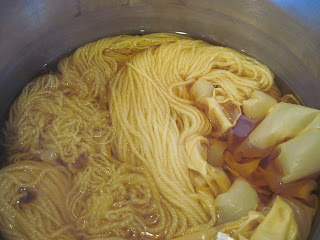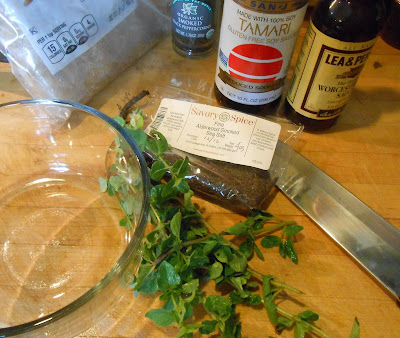Dyeing with spring apple leaves
Kathy has a wonderful 40 or so year old apple tree in her front yard. It is a magnificent craggy tree that produces yellow apples good for eating.
In the spring, she gathers a bucket of apple leaves and we make color.
As with most wild things, the color created is yellow. Spring apple leaves mordanted with alum make a wonderful buttery yellow we love.
With iron mordant, you get a dark brownish olive in our water.
Here is a skein of iron mordanted apple leaf yarn. There is actually a bit more olive in the color than the camera found. (I wish the camera would take what I see, that is always a problem photographing colors.)
Our method:
Fill your dyeing pot with fresh apple leaves, add water to cover. Put to simmer on the stove for about an hour. How long the pot is on the stove depends on how long it takes it to come to a simmer. Don't skimp on the time the leaves simmer. Dyeing with natural dyestuffs is not for the impatient.
To make your life easy, put the leaves in a big bag to make them simple to remove. I get the 5 gallon paint strainer bags from Sherwin Williams but I hear they are available at other places where paint is available. You can also use a washer bag. It makes a giant tea bag and is a lot easier than trying to fish out the bits and pieces. Or trying to shake the VM out of your dyed yarn!
While this is going on, make sure the things you want to dye are tied well. Make a "figure 8" or more of your ties. Tying tightly will give you a variegated skein of the color you are dyeing and your base color yarn. (So if your yarn is white - where you tie will most likely remain white while the rest of the skein will dye.) If you want a uniform color, tie loosely.
Weigh your dry yarn.
Mordant your yarn with your choice of mordants.
Everyone will tell you how to do this differently, so here is how I do it.
For alum, I weigh the yarn in grams. Then 10% of the weight of dry yarn in alum, and 1% in cream of tarter goes into the pot. So for 700 grams of wool yarn, I use 70 grams of alum and 7 grams of cream of tarter.
For iron, I weigh the yarn in pounds. Then I use 2 tblsp of iron sulfate per pound. If it is less than a pound, I get out the calculator.
It keep things straight for me somehow to do it this way. It doesn't make any sense but it does.
Wet your yarn in cool water, don't agitate it a lot when it's wet or it might felt.
Simmer the yarn and mordant in enough water so the yarn can have some space. I gently push the yarn around for the first few minutes. The minimum time I suggest is 60 minutes at a simmer. Again, don't forget to wait until the pot is at a simmer before starting your timer. (You will want a timer if you do this much. You think you will remember when you put the yarn in. You won't. Set the timer.) Longer is fine, over night is fine.
After the mordanting is done, carefully extract the yarn from the pot. I use tongs and grab the skein where the ties are to try to keep the skein from going all funky. I put the skein in a pail and let it cool down some.
Rinse the excess mordant off the skein with water that is about the same temperature as the skein. If you are using tap water, direct it at the side of the pail not on the skein to prevent felting.
Remove the dye material (see if you use the bag, just lift it out and let it drain into a big bucket). Add your mordanted skein to the pot and simmer until you have the color you like, usually 1 hour or so. Again, set the timer.
Remove the skeins, squeeze any excess dye out of the skein and return to the pot. You can use the dye several times usually. You will get lighter colors but those can be very pretty.
Let the skein cool.
Rinse the skein carefully until the excess dye is gone. The excess dye will not some how magically adhere to your skein. It will just make a mess in the future. Be ruthless.
I will talk about how to reduce your water usage in dyeing in another post.
So get out there and dye!
I get mordants from:
Griffin Dye Works
http://www.griffindyeworks.com/store/index.php?main_page=index&cPath=1_2
or
Hill Creek Fiber Studio
http://www.hillcreekfiberstudio.com/HFS-ShopV8/contents/en-us/d16.html
You are welcome to share where you get your dyes and mordants in the comments section. I'd love to hear from you!
In the spring, she gathers a bucket of apple leaves and we make color.
As with most wild things, the color created is yellow. Spring apple leaves mordanted with alum make a wonderful buttery yellow we love.
 |
| Apple leaf and alum on wool yarn and silk scarves |
 |
| Apple leaf and iron on silk scarves and wool yarn |
Here is a skein of iron mordanted apple leaf yarn. There is actually a bit more olive in the color than the camera found. (I wish the camera would take what I see, that is always a problem photographing colors.)
Our method:
Fill your dyeing pot with fresh apple leaves, add water to cover. Put to simmer on the stove for about an hour. How long the pot is on the stove depends on how long it takes it to come to a simmer. Don't skimp on the time the leaves simmer. Dyeing with natural dyestuffs is not for the impatient.
To make your life easy, put the leaves in a big bag to make them simple to remove. I get the 5 gallon paint strainer bags from Sherwin Williams but I hear they are available at other places where paint is available. You can also use a washer bag. It makes a giant tea bag and is a lot easier than trying to fish out the bits and pieces. Or trying to shake the VM out of your dyed yarn!
While this is going on, make sure the things you want to dye are tied well. Make a "figure 8" or more of your ties. Tying tightly will give you a variegated skein of the color you are dyeing and your base color yarn. (So if your yarn is white - where you tie will most likely remain white while the rest of the skein will dye.) If you want a uniform color, tie loosely.
Weigh your dry yarn.
Mordant your yarn with your choice of mordants.
Everyone will tell you how to do this differently, so here is how I do it.
For alum, I weigh the yarn in grams. Then 10% of the weight of dry yarn in alum, and 1% in cream of tarter goes into the pot. So for 700 grams of wool yarn, I use 70 grams of alum and 7 grams of cream of tarter.
For iron, I weigh the yarn in pounds. Then I use 2 tblsp of iron sulfate per pound. If it is less than a pound, I get out the calculator.
It keep things straight for me somehow to do it this way. It doesn't make any sense but it does.
Wet your yarn in cool water, don't agitate it a lot when it's wet or it might felt.
Simmer the yarn and mordant in enough water so the yarn can have some space. I gently push the yarn around for the first few minutes. The minimum time I suggest is 60 minutes at a simmer. Again, don't forget to wait until the pot is at a simmer before starting your timer. (You will want a timer if you do this much. You think you will remember when you put the yarn in. You won't. Set the timer.) Longer is fine, over night is fine.
After the mordanting is done, carefully extract the yarn from the pot. I use tongs and grab the skein where the ties are to try to keep the skein from going all funky. I put the skein in a pail and let it cool down some.
Rinse the excess mordant off the skein with water that is about the same temperature as the skein. If you are using tap water, direct it at the side of the pail not on the skein to prevent felting.
Remove the dye material (see if you use the bag, just lift it out and let it drain into a big bucket). Add your mordanted skein to the pot and simmer until you have the color you like, usually 1 hour or so. Again, set the timer.
Remove the skeins, squeeze any excess dye out of the skein and return to the pot. You can use the dye several times usually. You will get lighter colors but those can be very pretty.
Let the skein cool.
Rinse the skein carefully until the excess dye is gone. The excess dye will not some how magically adhere to your skein. It will just make a mess in the future. Be ruthless.
I will talk about how to reduce your water usage in dyeing in another post.
So get out there and dye!
I get mordants from:
Griffin Dye Works
http://www.griffindyeworks.com/store/index.php?main_page=index&cPath=1_2
or
Hill Creek Fiber Studio
http://www.hillcreekfiberstudio.com/HFS-ShopV8/contents/en-us/d16.html
You are welcome to share where you get your dyes and mordants in the comments section. I'd love to hear from you!




Comments